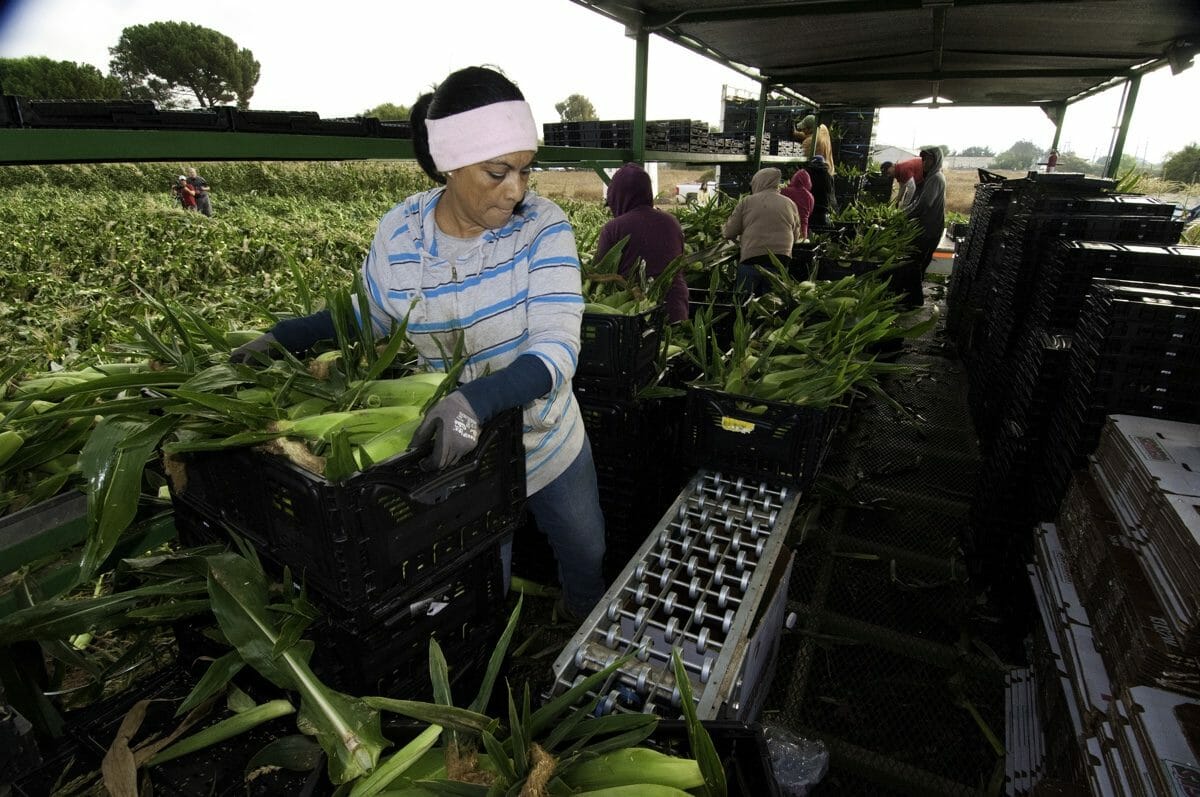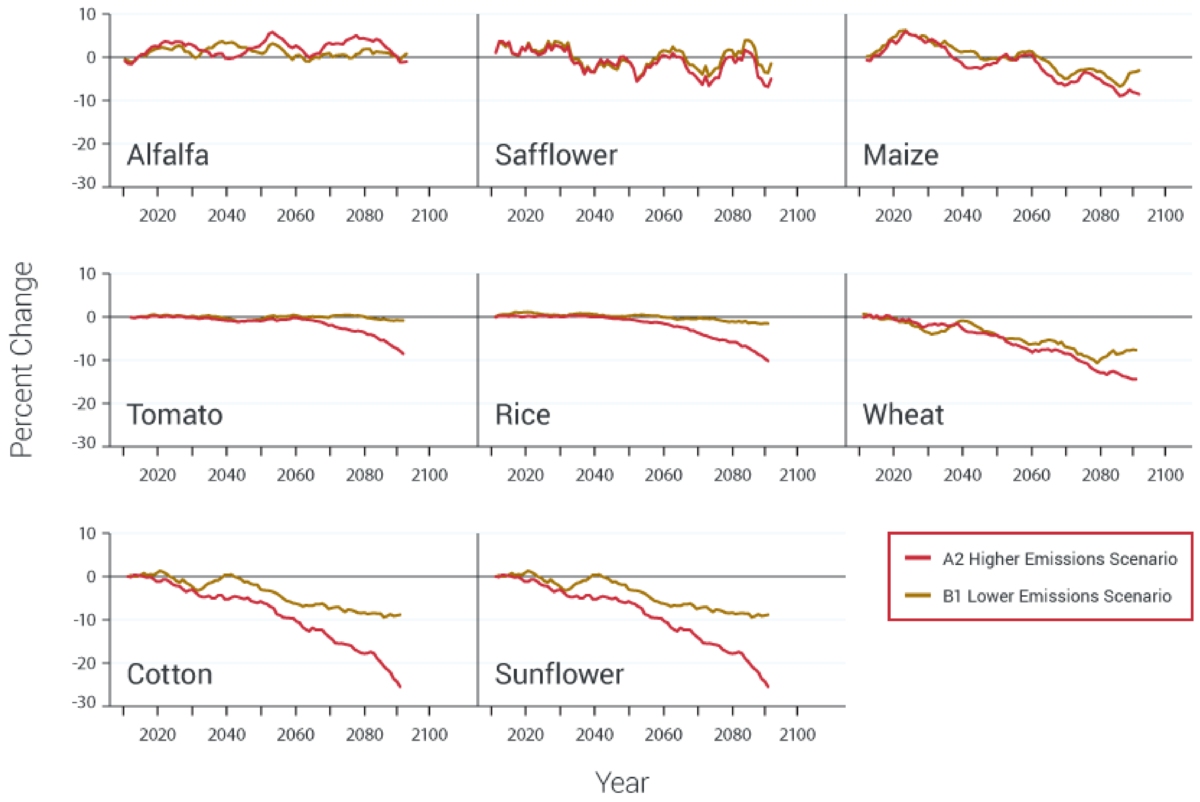Study Details How Climate Change Will Affect California Agriculture
A study provides an overview of California’s agricultural industry as it faces climate change.
Study Details How Climate Change Will Affect California Agriculture
A study provides an overview of California’s agricultural industry as it faces climate change.

To put it in the words of the scientists themselves: “The detailed review presented in this paper provides sufficient evidence that the climate in California has changed significantly…and justifies the urgency and importance of enhancing the adaptive capacity of agriculture and reducing vulnerability to climate change.”
The detailed review they’re talking about is a comprehensive analysis of various climate-related trends over the past century or so – precipitation, temperature, droughts, extreme weather conditions, and the amount of snowpack in the Sierra Nevada mountains (which provides much of California’s agricultural water) – to develop forward projections for the state’s very complex agricultural landscape. The study also looked at a handful of California’s more vital edibles, including walnuts, oranges, almonds, grapes (wine and table), and avocados.

The results are as varied as the state’s agricultural landscape. “California agriculture is very diverse and since each crop responds to climate differently, climate adaptation research should be locally focused,” write the study’s authors. But there are trends, and those trends are scary.
Among the warning signs found in California are increased maximum and decreased minimum temperatures, unpredictable precipitation, reduced snowpack, and a greater frequency of climate emergencies (like droughts and floods). By tracking those factors in specific areas, the researchers are able to make certain predictions. For example: Fruits like apricots, peaches, nectarines, and plums have specific cold-weather requirements (at least as they’re grown now). Currently, about 20-45 percent of the Central Valley is able to support those crops; by the end of the century, only 10 percent of that same area will be suitable as daytime heatwaves increase and nighttime temperatures rise. For crops requiring even more cold weather, like apples, cherries, and pears? “Virtually no areas will remain suitable by 2041-2060,” reads the study. Those aren’t major crops for the Central Valley today, but in the mid-1990s, California produced 8.5 percent of the nation’s apples. In a few decades? Zero percent.

The study makes it very clear that climate change will affect different crops in different ways. Certain locations are more at risk; the Salinas Valley and the San Joaquin Valley looks to be the most vulnerable, while Northern California’s wine country may not be hit as hard. Wine grapes may not suffer a yield decrease at all, but their flavor, aroma, and color may be affected. Alfalfa yields may actually see an increase, while tomatoes and rice yields are predicted to remain unchanged. Other crops, however, like oranges, almonds, and avocados, are likely to see moderate to substantial declines in yield – and as the population grows, that’s a change humanity will have to deal with.
You can read the full study here.
SaveSaveSaveSave
Follow us
This work is licensed under a Creative Commons Attribution-NoDerivatives 4.0 International License.
Want to republish a Modern Farmer story?
We are happy for Modern Farmer stories to be shared, and encourage you to republish our articles for your audience. When doing so, we ask that you follow these guidelines:
Please credit us and our writers
For the author byline, please use “Author Name, Modern Farmer.” At the top of our stories, if on the web, please include this text and link: “This story was originally published by Modern Farmer.”
Please make sure to include a link back to either our home page or the article URL.
At the bottom of the story, please include the following text:
“Modern Farmer is a nonprofit initiative dedicated to raising awareness and catalyzing action at the intersection of food, agriculture, and society. Read more at <link>Modern Farmer</link>.”
Use our widget
We’d like to be able to track our stories, so we ask that if you republish our content, you do so using our widget (located on the left hand side of the article). The HTML code has a built-in tracker that tells us the data and domain where the story was published, as well as view counts.
Check the image requirements
It’s your responsibility to confirm you're licensed to republish images in our articles. Some images, such as those from commercial providers, don't allow their images to be republished without permission or payment. Copyright terms are generally listed in the image caption and attribution. You are welcome to omit our images or substitute with your own. Charts and interactive graphics follow the same rules.
Don’t change too much. Or, ask us first.
Articles must be republished in their entirety. It’s okay to change references to time (“today” to “yesterday”) or location (“Iowa City, IA” to “here”). But please keep everything else the same.
If you feel strongly that a more material edit needs to be made, get in touch with us at [email protected]. We’re happy to discuss it with the original author, but we must have prior approval for changes before publication.
Special cases
Extracts. You may run the first few lines or paragraphs of the article and then say: “Read the full article at Modern Farmer” with a link back to the original article.
Quotes. You may quote authors provided you include a link back to the article URL.
Translations. These require writer approval. To inquire about translation of a Modern Farmer article, contact us at [email protected]
Signed consent / copyright release forms. These are not required, provided you are following these guidelines.
Print. Articles can be republished in print under these same rules, with the exception that you do not need to include the links.
Tag us
When sharing the story on social media, please tag us using the following: - Twitter (@ModFarm) - Facebook (@ModernFarmerMedia) - Instagram (@modfarm)
Use our content respectfully
Modern Farmer is a nonprofit and as such we share our content for free and in good faith in order to reach new audiences. Respectfully,
No selling ads against our stories. It’s okay to put our stories on pages with ads.
Don’t republish our material wholesale, or automatically; you need to select stories to be republished individually.
You have no rights to sell, license, syndicate, or otherwise represent yourself as the authorized owner of our material to any third parties. This means that you cannot actively publish or submit our work for syndication to third party platforms or apps like Apple News or Google News. We understand that publishers cannot fully control when certain third parties automatically summarize or crawl content from publishers’ own sites.
Keep in touch
We want to hear from you if you love Modern Farmer content, have a collaboration idea, or anything else to share. As a nonprofit outlet, we work in service of our community and are always open to comments, feedback, and ideas. Contact us at [email protected].by Dan Nosowitz, Modern Farmer
March 1, 2018
Modern Farmer Weekly
Solutions Hub
Innovations, ideas and inspiration. Actionable solutions for a resilient food system.
ExploreExplore other topics
Share With Us
We want to hear from Modern Farmer readers who have thoughtful commentary, actionable solutions, or helpful ideas to share.
SubmitNecessary cookies are absolutely essential for the website to function properly. This category only includes cookies that ensures basic functionalities and security features of the website. These cookies do not store any personal information.
Any cookies that may not be particularly necessary for the website to function and are used specifically to collect user personal data via analytics, ads, other embedded contents are termed as non-necessary cookies.
Most of the decline in the central valley is caused by sending 95% of the rain water straight out to the ocean. We can thank the environmentalists & their hold on Sacramento for that fiasco.